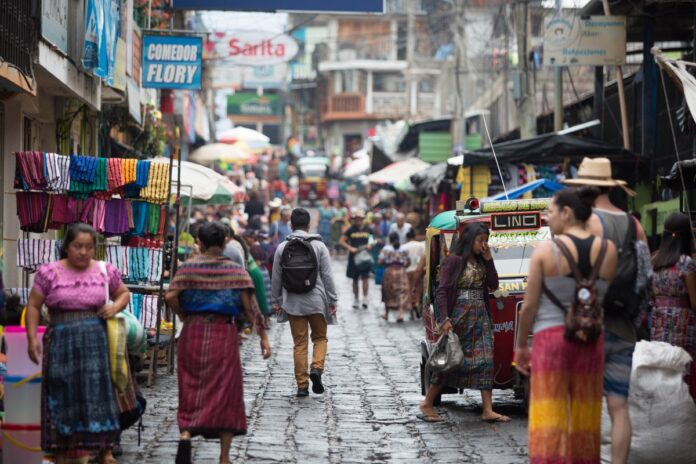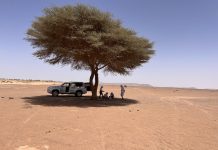The quiet Mayan Tz’utujil town of Santiago Atitlán has long been a destination for tourism, even during the darkest days of Guatemala’s thirty-six-year internal armed conflict. Tourists are drawn by the picturesque Lake Atitlán and the Indigenous traditions of the town. But in recent years, it has been marred by pandemic and, despite a reported return to normal, migration is on the rise.
“We have around three people who have gone to the United States,” Juan Manuel Ramierez, a local evangelical preacher told The Progressive in an interview in April 2022.
He points out that migration from this town to the United States was rare fifteen years ago. Now, he says, it’s become routine.
“In times of [internal armed] conflict only a few people left,” Ramierez adds. “But the pandemic came to affect the economy, so there are people who choose to go to the United States.”
Diego Sapol, a local academic researcher, explains that migration from the community has increased in the last two years. “There are a lot of people who are looking for a way to get that money to go to the United States to find an opportunity,” Sapol tells The Progressive.
“The lack of employment has affected a lot [of people],” he says. “There are some families that sometimes don’t even have enough for their children’s education, food, or healthcare. So they cross into the United States and give their children a decent life.”
The current cost for a coyote, or migrant guide, from Santiago Atitlán is currently around 125,000 Quetzales, or more than $16,000. Sapol himself has been approached about migrating, but he has no interest at the moment.
“I’ve thought about going many times,” Sapol says. “Many times I have thought it would be better to go [to the United States] to look for an opportunity.”
Due to inflation, the cost of living has increased across Guatemala. But as costs increase, daily wages have hovered around fifty or sixty Quetzales per day (between $6.50 and $7.75).
A similar phenomenon is occurring just a short boat ride away in the municipality of San Pedro la Laguna, also a Mayan community. Since the beginning of the pandemic people from San Pedro have sought to reach the United States to find opportunity.
The town sits on the western shore of Lake Atitlán. It is popular with tourists in the alternative spiritual movement and with retired Israel Defense Forces soldiers. But this has never contributed to the development of the local economy, and worse, the presence of tourists has forced many local residents from their markets.
“Tourism has benefits for only certain groups,” Sapol says. “Primarily the people who own spaces on the edge of the lake.”
The tourism industry in these towns with largely Indigenous full-time residents has done little to develop the community. Opportunities for young people, for example, remain limited. This situation is especially dire for residents who have higher levels of education, as there are few opportunities for work.
At least three of the victims of the tragedy in San Antonio, Texas in June 2022, where fifty-three migrants died in a trailer, were from villages that sit in the Atitlán basin.
‘Many times I have thought it would be better to go [to the United States] to look for an opportunity.’
The region has also seen the concentration of land into the hands of foreigners who seek to profit from tourism. Yet in spite of this, the Guatemalan government continues to promote tourism as a means of economic development.
“The model, the style of economic growth, is completely exhausted,” Jonathan Menkos, director of the Central American Institute for Fiscal Studies, tells The Progressive. “And no flow of tourism or direct foreign investment can compensate for that style of economic growth that does not generate enough employment or enough conditions to maintain people.”
One of the few opportunities in the region is to meet the tourists’ demand for drugs. The presence of drug culture and narcos in the community contributed to the town being listed as a red zone for U.S. peace corps volunteers, according to participants in the U.S. program.
“There are many children, there are young ladies and there are mothers [and] older men who are [selling drugs] because of the lack of employment,” Sapol says. “The same [economic] necessity forces them to do things that are crimes.”
Faced with this image of being a destination for drugs, the Guatemalan Foreign Ministry and Ministry of tourism launched an international campaign entitled “Enjoy Drug-Free Guatemala.” But the lack of oversight and regulation around the lake has created a destination where impunity reigns.
“What hope is there in the country when there is a gang of thieves ruling [the country]?” Juan José Hurtado, the director of the migrant advocacy association Pop No’j, tells The Progressive. “When what [these thieves] do is persecute people who try to act correctly; when what is seen is an increase in prices and that the basic cost of living is going up, and with people going through hardships to survive.”
Added to this, violence and extortions brought about by the economic crisis are steadily increasing. This means that opening small businesses for many is almost unobtainable.
“[This] is a country that does not offer a future for anyone,” Hurtado says. “There is no hope in Guatemala and hopelessness is an issue that forces people to leave.”










